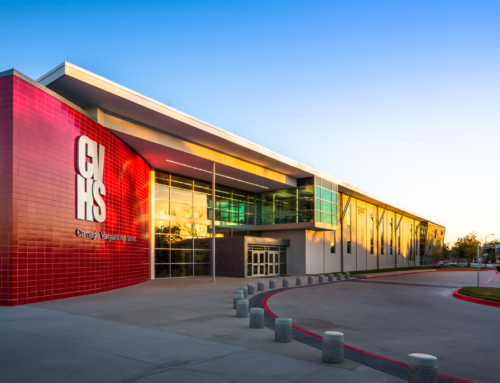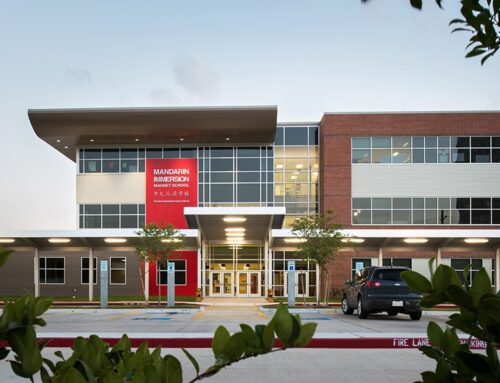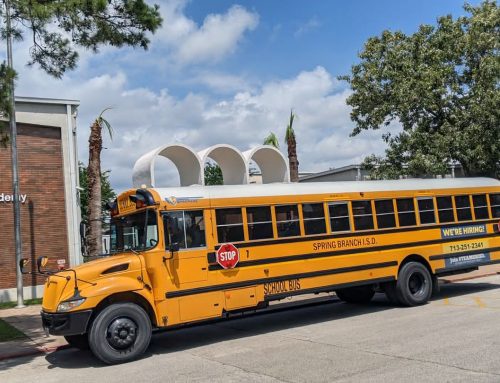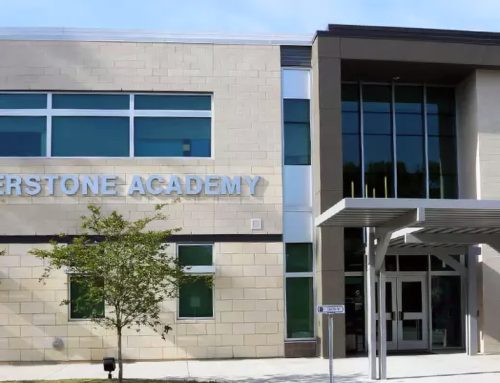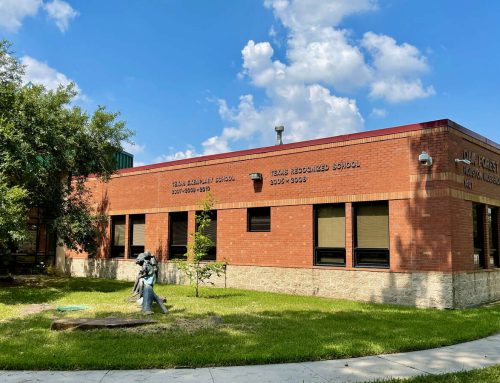
Every child is unique, and families want to make sure they choose the best right school for their child. As such Houston is home to more than 350 private schools enrolling more than 66,000 students. Additionally, more than 15,000 public school students attending Houston ISD also get to choose between nearly 240 HISD magnet schools each year.
But evaluating and comparing the hundreds of school options in Houston can be a daunting task, especially when each child and family have different criteria for what they want. Some families want a school with a strong academic focus, while others want a solid mix of academics, sports, and extracurriculars.
However, remember that the most important criteria—your child’s fit and happiness—cannot be quantified in the sections that follow. At the end of the day, the best school for your child is the one that provides them with a great education and opportunities for them to showcase their creativity, athleticism, interests, and anything else that may bring them joy.
This advice article leverages our more than 20 years of working with thousands of students to help make your school choice journey a little bit clearer and easier to manage.
Like so many divisive issues in American society, the decision between selecting a public versus private school usually comes down to a debate between parties who have no intention of changing their minds. However, partisans of either side of the debate should rejoice in that Houston offers great options whichever route they decide to choose.
Application vs. Zoned Public Schools
With very few exceptions, public schools only accept students residing within the boundaries of the school’s district, which means the student’s place of residence must be within the district’s boundaries. In addition, each public school will usually only accept students living within the designated zoned area of that school.
If you want your child to attend a school that allows automatic enrollment based off of zone, you will need to buy or rent a home in that school’s enrollment zone.
Gifted/Talent Magnet and Vanguard Programs
Children who function at an above average level can be tested for the Gifted/Talented (G/T) designation. Currently, about 15% of students in HISD are designated as G/T. Most G/T children love to learn, learn faster than their peers, and exhibit creativity or insight in their thoughts and actions.
In order for a student to be designated Gifted/Talented (G/T), a parent, a teacher, or the student must nominate the student for testing. Alongside the student’s G/T test results, the G/T Admissions Committee at the student’s school will also take into account the student’s grades, scores on other standardized tests, and teacher recommendations.
Vanguard programs work to meet the needs of G/T students, and they are a type of magnet program. Neighborhood vanguard programs operate on non-dedicated G/T campuses to meet the needs of G/T students. All teachers of G/T students will have G/T training in order to meet G/T students’ needs at all schools. Vanguard Magnet programs are campus-wide programs, so the whole school is specifically for G/T students.
Houston ISD (HISD) structures its magnet programs in three different ways:
- Schoolwide Magnet – All students, zoned and applicants, benefit from this specialized program; no application necessary for zoned students to benefit.
- Dedicated Magnet – No students are zoned to these schools; everyone is admitted based off their qualifying applications.
- School-Within-A-School (SWAS) – Admitted students benefit from a specialized program but may also take normal classes; zoned students generally may participate in the special program without applying.
Within the three types of structures for magnet programs, HISD offers eight programs:
- Vanguard – advanced curriculum for G/T students only
- International Baccalaureate (IB) – specialized curriculum not necessarily limited to G/T only students
- Montessori – Program based on using a child’s natural instincts to develop a unique learning experience
- STEM – Science, Technology, Engineering, and Mathematics focused program
- Language – Program for the advancement of multiple foreign languages
- Fine Arts – Performing and visual arts programs
- College Prep – Program offering dual high school and college enrollment
- Career Academies – Sixteen vocational programs
Parents looking into private schools will find that the majority of them are religious affiliated schools. For example, approximately 60% of Houston private schools are religiously affiliated, and within this group 50% are Catholic affiliated, while the remainder are Baptist, Episcopal, Jewish, Presbyterian, or non-denominational Christian. This affiliation can have broad implications for students, including compulsory daily worship, required religion classes, and differing methodologies and perspectives presented in the curriculum.
Parents of children not ascribing to the school’s stated faith should think carefully about how comfortable their children will be in a religious setting. However, parents should also know that most of the schools here are tolerant of other faiths and, in fact, openly embrace them. When weighing the different options, parents will be well served by asking about the school’s policy on diversity and inclusion.
When considering the location of a school, safety is of upmost importance. In Houston, for example, most of the schools, public and private, are all in relatively safe neighborhoods; HISD schools in particular are secured further by their own police force.
Another factor to consider is the commute required for your child to arrive at school. Many schools may be relatively close to your home, but traveling during peak hours may add as much as an hour to you commute depending on your location.
As for facilities, some schools definitely stand out above other schools in terms of newness, expansiveness, and quality of facilities. However, it is also usually the case that schools with older or more limited facilities will have ambitious plans to expand during a time frame that would still benefit a newly admitted child.
Finally, athletic facilities tend to have the most variability, with schools further from a city center benefitting from more space.
The admissions process is generally straightforward and well defined by schools. Parents can anticipate the following:
Application
- Family background
- Student’s academic records (if applicable)
- Teacher recommendations
- Student short answer questions
Standardized Testing
- ISEE or HSPT (Private and Catholic schools only)
- IQ test, such as the WPPSI, WISC, or CogAT
School Visits
- Attending an open house
- Shadowing a currently enrolled student or faculty member
- Interviewing with the admissions department (Private Schools Only)
While the process is mostly transparent, it’s the deliberations behind closed doors that are not. Unlike major colleges and universities, most secondary schools do not publish statistics or concrete advice about what kind of student they seek.
Finally, nearly all of the schools openly acknowledge giving preferential admissions treatment to certain applicants, such as legacy students (parents or siblings attended the school). For most schools private and public magnet, preferential treatment works in two ways. Some schools will examine and decide on applications from preferred applicants before reviewing general applicants, meaning that there are fewer spaces available. Other schools state that they use preferential treatment only as a tie-breaking tool for when two students are identical.
For religious schools, members of the specific church (not denomination) associated with the school usually receive priority enrollment decisions. For nearly all schools, siblings of currently enrolled students, children of alumni parents, and children of faculty members generally receive preferential treatment. For some schools, the number of applicants receiving preferential treatment can easily exceed 50% of the applicant pool, making it difficulty for families not already in the school’s “community .”
Foreign language study options have grown throughout most schools. For example, almost every Houston-area school with a foreign language program offers Spanish, while French, Chinese Mandarin, and Latin follow in popularity.
In 2013, Chinese overtook Latin in popularity and is quickly finding favor over French. Students also benefit from Texas’s embrace of the International Baccalaureate curriculum. Schools offering the IB curriculum are technically required to offer all of the IB’s many courses, including more than fifty languages.
Numerous research studies (too many to cite here) have demonstrated a positive correlation between the study of foreign language and increased cognitive ability. A 1999 study among middle school students found that students randomly assigned to learn 30 minutes of Spanish three times a week scored significantly higher in math and language skills than non Spanish learners on a standardized achievement test.
Most recently, a Swedish study found that language learning leads to brain growth in the hippocampus and cerebral cortex, parts of the brain that are correlated with better cognitive and motor skills. The key takeaway from these studies is that language learning also increases students’ cognitive abilities particularly in analytical and interpretative capabilities leading to higher English, math, and science scores.
Knowing a second language increases an applicant’s competitiveness in the job market. The importance of foreign language skills for increased market competitiveness was perhaps best highlighted when President George W. Bush announced a national $175 million initiative in 2006 to train more students. Governments and corporations need Americans who can seamlessly work with colleagues from international offices, translate multinational documents, and serve clients from around the world.
Finally and perhaps most difficult to quantify is how knowing another culture’s language broadens one’s horizons and provides new and different perspectives. Many of General Academic’s clients have traveled abroad to non-English speaking countries like Germany or China as English-only speakers.
However, knowing the native tongue opens up so many more opportunities for exploration and cultural exchange.
For example, most Americans know that 13 is an unlucky number. In China, the unluckiest number is four, because its pronunciation is nearly identical as the Mandarin word for death! Armed with this knowledge, Americans would be well advised to not order four dishes when dining with their Chinese friends or perhaps not to schedule a flight for a Chinese client at 4:44 in the afternoon.
Parents should look for schools with multiple academic tracks and broad curriculums to fit their specific child’s need. Fortunately, many of schools have at least three academic tracks:
- On-track,
- Honors, and
- Advanced Placement / International Baccalaureate.
The areas where schools tend to differ are:
- How many honors and AP/ IB classes they offer
- When students are eligible to take more advanced classes (i.e. 10th or 11th grade)
- The maximum number of advanced classes the school allows a student to take
Graduation requirements vary from school to school but generally require a similar number of credit hours (1 hour equals one year of study):
- English (4)
- Math (3)
- History (3)
- Language (2)
- Art (2)
- Electives (2)
- Technology (1)
Where schools tend to differ is on the math, history, language, and elective components. Many schools only require three years of math study, while some require four. Similarly, two years of study in the same language is the general foreign language requirement, but some schools require three and even four years of study.
When requirements are lower in a core subject area like math or foreign language, the amount of time for electives increases. Most schools generally characterize art, technology, many social science classes, and very advanced core subject classes as electives.
The breadth and depth of a school’s arts curriculum is almost directly proportional to its enrollment size. Smaller schools may only offer basic visual arts and music classes.
However, some of the larger schools—more than 100 students per grade—have much larger offerings that would rival some small colleges. They might offer upwards of 50 classes ranging from studio art to guitar to acting and photography.
The schools with the larger art departments also usually have more flexibility in graduation requirements, thereby allowing students to take advantage of their non-core curriculum offerings.
Additionally, arts facilities are increasingly a source of pride for the best-funded private schools; some schools feature fantastic performance venues that would rival the municipal halls of small cities in terms of size, technical sophistication, and finish.
When evaluating schools for a child with special needs, parents should ask about the school’s accommodation and modification policies. By Federal law, most schools are required to accommodate for diagnosed learning differences (extended test timing, typing assignments versus writing, etc.), but they are not required to be happy about it.
The law does not require schools to modify curriculums (i.e. teach at a different pace versus an on-track curriculum). All private schools will accommodate minor to mild learning differences within their ability; however unlike public schools, they will generally not modify curriculums to better suit an individual student’s needs. The fact that they are not overly accommodating is usually the result of limited resources.
Students with learning differences will find extreme differences in the level of accommodations and/ or modifications that they will receive from school to school. When a student with a diagnosed learning difference enrolls at a public school, that school is legally obligated to provide a wide range of services.
Conversely, main-stream private schools must only provide a basic level of accommodation that often times does not meet the needs of students with moderate to severe learning differences. For example, in Houston, for these types of students wishing to attend a private school, there are at least three private schools (Briarwood, Joy, Tenney) that specifically cater to students with special needs such as ADHD, dyslexia, dysgraphia, and memory retention learning differences. Additionally, some larger private schools like St. Pius X and Strake Jesuit have dedicated “Learning Resource Centers” staffed with counselors and armed with strategies and faculty support to better help students navigate their curriculums.
The other schools, even when not specifically cited, will accommodate students with diagnosed learning differences. Furthermore, a handful of private schools employ counselors to help students who may not have diagnosed learning disabilities but could still benefit from additional learning assistance beyond that offered in on-track curriculum classes.
Nearly all schools offer at least two or three basic computer classes; some schools offer more advanced classes such as web design and AP Computer Science.
The heavy backpacks that weigh more than the child wearing them are increasingly falling out of favor for computers and tablets. Many schools provide Apple or Android tablets in lieu of textbooks on a one tablet per one child basis. Even more schools require and provide laptops on an individual basis.
For the schools they don’t provide computers for each student, most allow use of this technology in class when a teacher permits. Additionally, all of the schools have computer labs available for student use, and generally find some way to integrate daily technology use into the curriculum.
Extracurricular activities include almost anything under the sun that doesn’t fit in the core curriculum. Most schools allow students to pursue any type of interest as long as students can find a faculty member to sponsor the activity through a club. Parents should know that the quality of most student-run clubs vary widely from year to year depending on the student leadership, faculty sponsors, membership, and funding.
These clubs, activities, and honor societies can help provide students with balance and learning opportunities outside of the core curriculum. Additionally, many competitive activities serve to nurture advanced talents in academics. Examples of competitive activities include speech and debate, mock trial, Model UN, quiz bowl, math club, and student government. Artistic activities include dance, theater and photography.
Below are descriptions of some popular, well-established competitive activities that parents should be aware of for their children. An added benefit of participating in these events is special recognition that may boost a college applicant’s standing.
Math
Mathcounts is a premier non-profit foundation that sponsors middle school math competitions throughout the nation. Teams of sixth, seventh, and eighth graders compete with other schools by solving critical thinking problems involving the extensive use of topics such as geometry and algebra. Interested students will need to join their school’s team to compete. Schools fielding a Mathcounts team will have regular meetings in which students continually improve their math and reasoning skills through advanced practice.
American Mathematics Competitions (AMC) is like the Olympics for math. Sponsored by the Mathematical Association of America (MMA), the competition starts with the AMC 8 (7th and 8th graders), AMC 10 (9th and 10th graders), and AMC 12 (11th and 12th graders). The top 2.5% of AMC test takers are invited to participate in the American Invitational Mathematics Examination (AIME), from which the MMA selects top performers to compete in the United States of American Mathematical Olympiad (USAMO). From the USAMO, the MMA selects approximately 30 top achievers to attend its Mathematical Olympiad Summer Program, from which six students are selected to join the “United States Math Team” for an international competition. Students participating in the AMC exams receive scores that, when high, are favorably viewed by elite universities. To sit for the AMC, students must be enrolled in the appropriate grade at a school registered with the MMA. School registration involves enrollment fees and the cost of test materials.
Mu Alpha Theta is a national honor society for the advancement of mathematics with approximately 100,000 members across 2000 schools in the US. Founded by members of the University of Oklahoma math department in 1957, Oklahoma remains the organization’s functional headquarters. Mu Alpha Theta sponsors numerous math competitions throughout the year at the state and national level. Additionally, the organization awards scholarships and grants to both chapters and individuals. Students need join a chapter of Mu Alpha Theta in order to participate in its competitions and be eligible for scholarships. Chapters are normally offered through the student’s school.
Science and Engineering
Robotics clubs continue to grow increasingly popular as they blend the nation’s general need for more advanced skills in science, technology, engineering, and mathematics (STEM) with hands-own, interactive, fun. Although there isn’t a single organization that governs robotics competitions in the US, there are many competitions including First Robotics and VEX Robotics (mostly high school), First Tech Challenge (middle and high school), and the First Lego League and Early Robotics (elementary school). Funding tends to be the biggest challenge for schools offering a robotics club, as they must secure a knowledgeable instructor, materials to build a competitive robot, and the registration fee for contests, which usually goes into the thousands of dollars.
The National Science Bowl is a science and mathematics competition managed by the US Department of Energy. Both high school and middle school teams can compete in more than 120 regional competitions (70 high school, 50 middle school) before getting the chance to compete in an all expenses paid final competition in Washington DC. Competing teams consist of four contestants, an alternate, and a teacher coach. Topics tested in the fast-paced question and answer format tournaments include chemistry, biology, physics, mathematics, and energy. A highlight for middle school teams is building and racing model, electric cars.
The Siemens Competition and Intel Science Talent Search are among two of the most prestigious privately funded science competitions in the US. In both of these competitions, would-be Einsteins submit original research papers for judging. Regional winners or semi-finalists usually receive prizes worth about $1000 while those who make it to higher levels win as much as $100,000. However, winning the top prizes also carries a heavy burden; past finalists have gone on to win prestigious career awards like the Nobel Prize and MacArthur Fellowship.
Speech and Debate
The National Forensic League (NFL) is the pre-eminent “honor society” for speech and debate competitions for high school students. Students participate in competitions that may ultimately qualify them to participate in the big national tournament in a wide variety of events such as team debates (Policy), one-on-one debates (Lincoln-Douglas), mock US Congress debates (Congressional). Outside of “traditional debate,” students may also explore their more artistic side through events like Dramatic Interpretation, Humorous Interpretation, Poetry, and Storytelling. Qualifying for the national tournament involves participation in numerous local and regional competitions. Students must be a member of a registered school in order to compete in NFL sponsored competitions. Most schools will simply call their registered organization the speech and debate club/ team.
The National High School Mock Trial Championship (Mock Trial) is a nationwide competition pitting one team from each state against each other until one state’s team is proclaimed the winner. Teams qualify to participate in the national tournament through a series of local and regional tournaments. Competitions involve the presentation of hypothetical courtroom trials whereby each team consists of lawyers and witnesses. Students participating as lawyers give speeches, present and cross-examine witness, and make objections just like real lawyers in a contemporary American courtroom. Students participating as witnesses hone their acting skills to fill their roles and attempt to frustrate the opposing team’s lawyers during cross-examination. The Dallas Bar Association sponsors the Texas state-level competition. The non-profit organization National High School Mock Trial Championship, Inc. sponsors the national competition.
General Knowledge
Quiz Bowl is a competitive trivia event whereby high school teams will compete each other to participate in regional, state, and national competitions. Questions come from a variety of topics such as history, science, and literature.
Odyssey of the Mind (OM) is a creative problem solving competition with levels for students in k-5, 6-8, and 9-12. Each year, students devise a solution to a problem in one of five categories: vehicle, technical, classics (knowledge of architecture, art, literature), structure, and theatrics. Competing teams are usually limited to seven members and the cost of materials used in the solution is usually limited to $150. NASA usually sponsors competitions in one of the categories. Students must be a member of a dues paying, registered member to participate in all levels of competition.
University Interscholastic League (UIL) is the premier, exclusively Texas forum for just about all competitive events among most public and some private schools. In addition to facilitating competitive sports, the League also hosts 22 high school and 18 elementary and junior high contests in academics and literature. Competitions include speech and debate (in association with NFL), academic contests in categories like mathematics, science, and literary criticism, theatre, and journalism.
Academic Decathlon is a nationwide high school academic competition consisting of multiple-choice tests, “performance events,” and an essay. School teams usually consist of nine members that are divided into three levels of competition based on GPA. Teams win gold, silver, and bronze medals through local, regional, and state events before qualifying for the overall national tournament. Topics are related to a theme and include questions from art, economics, language/ literature, math, music, science, and social science.
No school here requires students to participate in competitive sports, but they do all have general physical fitness requirements. Many of the schools include athletics as one of their core values. Most of the schools profiled here field interscholastic men’s and women’s teams in a variety of sports including: baseball, basketball, cross-country, field hockey, football, golf, lacrosse, soccer, swimming, softball, tennis, track, volleyball, and wrestling.
Parents should inquire as to how many teams a school fields in each sport. For example, schools that have dedicated teams for freshman or intramural teams will allow more students to participate in the sport even if not competitively. When school teams are not much of an option, parents should keep in mind that many competitive opportunities exist outside of school as well.
Athletic facilities at schools vary widely. Some schools have brand new, state of the art facilities that would put moderate size colleges to shame with their new Olympic size swimming pools, four gyms, and three game fields. However, schools in more urban locations do not usually enjoy the same luxury of space as the more suburban schools. Finally, schools with older or less accommodating facilities often are actively fundraising to build or expand their offerings.
Depending on the location and the type of school, there will be a particular league that they will compete in.
For example, Houston schools generally compete in the following three leagues:
- Texas Association of Private and Parochial Schools (TAPPS)
- Southwest Preparatory Conference (SPC)
- University Interscholastic League (UIL)
At about 8% of US GDP, education is expensive. Whether parents pay through taxes or tuition, the cost is real and may very well be an important factor for families. Excluding the sunk cost of property taxes and/or a rent payment (which factors in taxes) public schools require no new cash outlay.
Conversely, private schools in Houston, for example, currently average over $26,896 a year, regardless of grade level and increasing approximately 5% per year. Private school tuition is not generally tax deductible. At these rates, over twelve years, private school tuition will set a family back at least $250,000 per child.
Click here to read our latest analysis on Houston private school tuition.
Conversely, critics argue that most teachers are not adept at teaching to a specific gender and that many students don’t learn according to gender stereotypes.
Proponents of single-sex education argue that co-education reinforces expected gender roles rather than helps break down stereotypes. Single-sex education, on the other hand, fights “gender intensification,” or the tendency of boys and girls to conform to prevailing cultural notions about each gender.
Students at single-sex schools are more likely to study subjects or join clubs considered non-traditional for their gender. Girls have more leadership opportunities and boys tend to become more collaborative.
With proper training, teachers can employ strategies that cater to different learning styles between the sexes. Students can act and answer questions without worrying about what the other gender might think.
The Case for All-Girls Schools
Girls at girls’ schools are more likely to study non-traditional courses (advanced math, physics, computer science), take leadership positions, and embrace athletics without fear of being perceived as unfeminine. At a girls’ school, a girl is always the top student, always the best athlete, always the Student Council President. In a girls’ school band, a girl plays each instrument—no instrument is considering a “boys’ instrument.” Girls are encouraged to be daring and to take risks.
The Case for All-Boys Schools
In recent years, girls have been out-pacing boys academically. Some boys think of academic achievement as emasculating. This growing problem of unmotivated boys and underachieving young men can be better addressed in a single-sex environment. Boys in boys’ schools are more than twice as likely to study foreign languages, art, music, and drama. Choirs are much more popular among boys at all-boys schools than among their coed peers. No boy is a “target” for joining a club comprised mainly of girls.
Without the presence of girls, boys tend to stop acting out as class clowns to avoid seeming imperfect. They are more willing to appear vulnerable when expressing their reactions to an English reading. Additionally, some social pressures are lessened, allowing boys to mature at their own rate.

